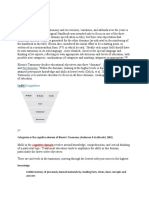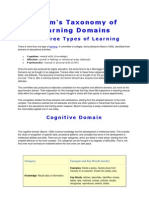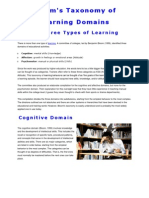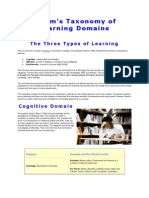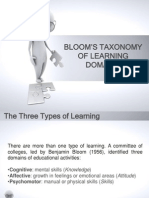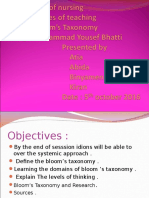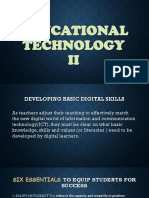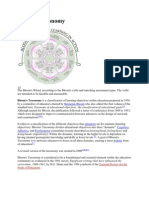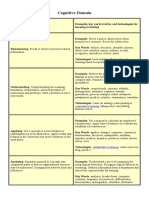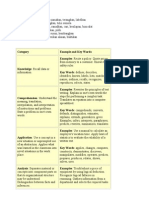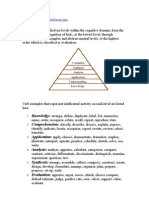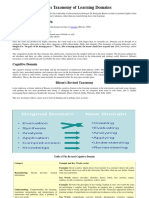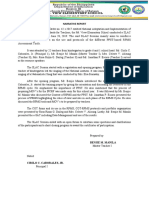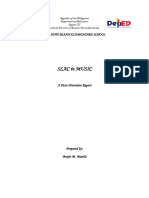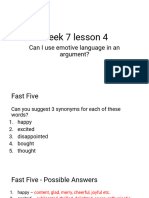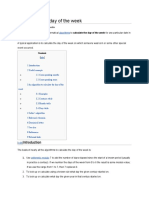Edit Source: Cognitive
Edit Source: Cognitive
Uploaded by
Benjie Modelo ManilaCopyright:
Available Formats
Edit Source: Cognitive
Edit Source: Cognitive
Uploaded by
Benjie Modelo ManilaOriginal Description:
Original Title
Copyright
Available Formats
Share this document
Did you find this document useful?
Is this content inappropriate?
Copyright:
Available Formats
Edit Source: Cognitive
Edit Source: Cognitive
Uploaded by
Benjie Modelo ManilaCopyright:
Available Formats
Cognitive[edit
source]
Categories in the cognitive domain of Bloom's Taxonomy (Anderson & Krathwohl, 2001)
Skills in the cognitive domain revolve around knowledge, comprehension, and critical thinking on a particular topic. Traditional education tends to emphasize the skills in this domain, particularly the lower-order objectives.
There are six levels in the taxonomy, moving through the lowest order processes to the highest:
Knowledge[edit
source]
Exhibit memory of previously learned materials by recalling facts, terms, basic concepts and answers
Knowledge of specifics - terminology, specific facts Knowledge of ways and means of dealing with specifics - conventions, trends and sequences, classifications and categories, criteria, methodology
Knowledge of the universals and abstractions in a field - principles and generalizations, theories and structures
Questions like: What are the health benefits of eating apples?
Comprehension[edit
source]
Demonstrate understanding of facts and ideas by organizing, comparing, translating, interpreting, giving descriptions, and stating the main ideas
Translation Interpretation Extrapolation
Questions like: Compare the health benefits of eating apples vs. oranges.
Application[edit
source]
Using new knowledge. Solve problems in new situations by applying acquired knowledge, facts, techniques and rules in a different way
Questions like: Which kinds of apples are best for baking a pie, and why?
Analysis[edit
source]
Examine and break information into parts by identifying motives or causes. Make inferences and find evidence to support generalizations
Analysis of elements Analysis of relationships Analysis of organizational principles
Questions like: List four ways of serving foods made with apples and explain which ones have the highest health benefits. Provide references to support your statements.
Synthesis[edit
source]
Compile information together in a different way by combining elements in a new pattern or proposing alternative solutions
Production of a unique communication Production of a plan, or proposed set of operations Derivation of a set of abstract relations
Questions like: Convert an "unhealthy" recipe for apple pie to a "healthy" recipe by replacing your choice of ingredients. Explain the health benefits of using the ingredients you chose vs. the original ones.
Evaluation[edit
source]
Present and defend opinions by making judgments about information, validity of ideas or quality of work based on a set of criteria
Judgments in terms of internal evidence Judgments in terms of external criteria
Questions like: Do you feel that serving apple pie for an after school snack for children is healthy?
Affective[edit
source]
Skills in the affective domain describe the way people react emotionally and their ability to feel other living things' pain or joy. Affective objectives typically target the awareness and growth inattitudes, emotion, and feelings.
There are five levels in the affective domain moving through the lowest order processes to the highest:
Receiving[edit
source]
The lowest level; the student passively pays attention. Without this level no learning can occur. Receiving is about the student's memory and recognition as well.
Responding[edit
source]
The student actively participates in the learning process, not only attends to a stimulus; the student also reacts in some way.
Valuing[edit
source]
The student attaches a value to an object, phenomenon, or piece of information. The student associates a value or some values to the knowledge he acquired.
Organizing[edit
source]
The student can put together different values, information, and ideas and accommodate them within his/her own schema; comparing, relating and elaborating on what has been learned.
Characterizing[edit
source]
The student holds a particular value or belief that now exerts influence on his/her behaviour so that it becomes a characteristic.
Psychomotor[edit
source]
Skills in the psychomotor domain describe the ability to physically manipulate a tool or instrument like a hand or a hammer. Psychomotor objectives usually focus on change and/or development in behavior and/or skills.
Bloom and his colleagues never created subcategories for skills in the psychomotor domain, but since then other educators have created their own psychomotor taxonomies.[11] Simpson (1972)[12] among other contributors, such as Harrow (1972) and Dave (1967), created a Psychomotor Taxonomy that helps to explain the behaviour of typical learners or high performance athletes. The proposed levels are:
Perception[edit
source]
The ability to use sensory cues to guide motor activity. This ranges from sensory stimulation, through cue selection, to translation. Examples: Detects non-verbal communication cues. Estimate where a ball will land after it is thrown and then moving to the correct location to catch the ball. Adjusts heat of stove to correct temperature by smell and taste of food. Adjusts the height of the forks on a forklift by comparing where the forks are in relation to the pallet. Key Words: chooses, describes, detects, differentiates, distinguishes, identifies, isolates, relates, selects.
Set[edit
source]
Readiness to act. It includes mental, physical, and emotional sets. These three sets are dispositions that predetermine a person's response to different situations (sometimes called mindsets). Examples: Knows and acts upon a sequence of steps in a manufacturing process. Recognize one's abilities and limitations. Shows desire to learn a new process (motivation). NOTE: This subdivision of Psychomotor is closely related with the Responding to phenomena subdivision of the Affective domain. Key Words: begins, displays, explains, moves, proceeds, reacts, shows, states, volunteers.
Guided Response[edit
source]
The early stages in learning a complex skill that includes imitation and trial and error. Adequacy of performance is achieved by practicing. Examples: Performs a mathematical equation as demonstrated. Follows instructions to build a model. Responds to hand-signals of instructor while learning to operate a forklift. Key Words: copies, traces, follows, react, reproduce, responds
Mechanism[edit
source]
This is the intermediate stage in learning a complex skill. Learned responses have become habitual and the movements can be performed with some confidence and proficiency. Examples: Use a personal computer. Repair a leaking tap. Drive a car. Key Words: assembles, calibrates, constructs, dismantles, displays, fastens, fixes, grinds, heats, manipulates, measures, mends, mixes, organizes, sketches.
Complex Overt Response[edit
source]
The skillful performance of motor acts that involve complex movement patterns. Proficiency is indicated by a quick, accurate, and highly coordinated performance, requiring a minimum of energy. This category includes performing without hesitation, and automatic performance. For example, players will often utter sounds of satisfaction or expletives as soon as they hit a tennis ball or throw a football, because they can tell by the feel of the act what the result will produce. Examples: Maneuvers a car into a tight parallel parking spot. Operates a computer quickly and accurately. Displays competence while playing the piano. Key Words: assembles, builds, calibrates, constructs, dismantles, displays, fastens, fixes, grinds, heats, manipulates, measures, mends, mixes, organizes, sketches. NOTE: The Key Words are the same as Mechanism, but will have adverbs or adjectives that indicate that the performance is quicker, better, more accurate, etc.
Adaptation[edit
source]
Skills are well developed and the individual can modify movement patterns to fit special requirements. Examples: Responds effectively to unexpected experiences. Modifies instruction to meet the needs of the learners. Perform a task with a machine that it was not originally intended to do (machine is not damaged and there is no danger in performing the new task). Key Words: adapts, alters, changes, rearranges, reorganizes, revises, varies.
Origination[edit
source]
Creating new movement patterns to fit a particular situation or specific problem. Learning outcomes emphasize creativity based upon highly developed skills. Examples: Constructs a new theory. Develops a new and comprehensive training programming. Creates a new gymnastic routine. Key Words: arranges, builds, combines, composes, constructs, creates, designs, initiate, makes, originates.
You might also like
- Ciampa CompTIASec+ 7e PPT Mod03Document42 pagesCiampa CompTIASec+ 7e PPT Mod03Anis Safwan100% (1)
- Quick Reference Guide For Installation of Dexis Imaging Suite Software On A WorkstationDocument8 pagesQuick Reference Guide For Installation of Dexis Imaging Suite Software On A WorkstationIranildo BarbosaNo ratings yet
- Blooms TaxonomyDocument6 pagesBlooms TaxonomyRaji PanduranganNo ratings yet
- Bloom's Taxonomy: Cognitive Domain (Knowledge-Based), Original VersionDocument6 pagesBloom's Taxonomy: Cognitive Domain (Knowledge-Based), Original VersionRein MagaroNo ratings yet
- Bloom's Taxonomy: HistoryDocument8 pagesBloom's Taxonomy: HistorylaseryleeNo ratings yet
- Domains: Cognitive Affective Psychomotor HolisticDocument5 pagesDomains: Cognitive Affective Psychomotor HolisticLeila SanchezNo ratings yet
- Bloom's TaxonomyDocument5 pagesBloom's TaxonomyRivanda DebiNo ratings yet
- Bloom Taxonomy of LearningDocument9 pagesBloom Taxonomy of LearningDavid BartonNo ratings yet
- Bloom's Taxonomy of Learning DomainsDocument9 pagesBloom's Taxonomy of Learning Domainsvansick007No ratings yet
- Bloom's TaxonomyDocument9 pagesBloom's TaxonomyIsrahana Shahril100% (1)
- Bloom's Taxonomy of Learning DomainsDocument10 pagesBloom's Taxonomy of Learning DomainsEduardo EdwaNo ratings yet
- Bloom's Taxonomy of Learning DomainsDocument10 pagesBloom's Taxonomy of Learning DomainsKellor NiohNo ratings yet
- Bloom's Taxonomy of Learning DomainsDocument10 pagesBloom's Taxonomy of Learning DomainsJose JosephNo ratings yet
- Home Site Map About Leadership Training Learning History Knowledge Performance Java Etc. News BlogDocument13 pagesHome Site Map About Leadership Training Learning History Knowledge Performance Java Etc. News BlogJoann Plaza ReforminaNo ratings yet
- Learning Domains or BloomDocument11 pagesLearning Domains or Bloomakuadalah308No ratings yet
- Learning Domains or Bloom's Taxonomy: T He Three Types of LearningDocument7 pagesLearning Domains or Bloom's Taxonomy: T He Three Types of LearningRisnantoganto SutarsoNo ratings yet
- Bloom's TaxonomyDocument8 pagesBloom's TaxonomyNoridah YusofNo ratings yet
- Bloom's Taxonomy of Learning DomainsDocument8 pagesBloom's Taxonomy of Learning DomainsSakura MyristicNo ratings yet
- Bloom's TaxonomyDocument19 pagesBloom's TaxonomyZubair KhanNo ratings yet
- CTR FinalDocument42 pagesCTR Finalmaria tabassumNo ratings yet
- Bloom's Taxonomy of Learning DomainsDocument5 pagesBloom's Taxonomy of Learning Domainsthanu_2010No ratings yet
- Bloom's Taxonomy - WikipediaDocument10 pagesBloom's Taxonomy - WikipediaHarshal VaidyaNo ratings yet
- Bloom Taxonomy: Rabiya KamranDocument7 pagesBloom Taxonomy: Rabiya KamranFahad Khan TareenNo ratings yet
- Bloom'S Taxonomy of Learning DomainsDocument27 pagesBloom'S Taxonomy of Learning DomainsKiran KhasaNo ratings yet
- The Three Types of Learning by BloomDocument8 pagesThe Three Types of Learning by BloomRosevil Egpit AlinNo ratings yet
- Seminar On Table of Specs (TOS)Document39 pagesSeminar On Table of Specs (TOS)Paulo Israel Escobal RemulloNo ratings yet
- Bloom'S Taxonomy of Learning DomainsDocument31 pagesBloom'S Taxonomy of Learning DomainsrometimbaNo ratings yet
- Bloom'S - Taxonomy - PPT AbidaDocument42 pagesBloom'S - Taxonomy - PPT AbidaBinyamin aurangzaibNo ratings yet
- Assessment LearningDocument67 pagesAssessment Learningmarlon_tayagNo ratings yet
- The Cognitive Domain Involves Knowledge and The Development of Intellectual SkillsDocument12 pagesThe Cognitive Domain Involves Knowledge and The Development of Intellectual SkillsChristian Edezon LopezNo ratings yet
- Blooms Taxonomy and Learning ThoriesDocument15 pagesBlooms Taxonomy and Learning ThoriesMuneeb AnjumNo ratings yet
- Cognitive Domain: Hidayatul Syaheeda Mohd Isa DPLI-SejarahDocument7 pagesCognitive Domain: Hidayatul Syaheeda Mohd Isa DPLI-SejarahNor AzimahNo ratings yet
- Instructional Objectives in Teaching and Learning of Social StudiesDocument1 pageInstructional Objectives in Teaching and Learning of Social StudiesMarc Dhavid RefuerzoNo ratings yet
- All 3 Blooms 2015Document4 pagesAll 3 Blooms 2015Lenie Sang-olanNo ratings yet
- Blooms TaxonomyDocument36 pagesBlooms TaxonomyMuniba ArshadNo ratings yet
- Bloom's Taxonomy - WikipediaDocument7 pagesBloom's Taxonomy - Wikipediaglh00No ratings yet
- Technology Midterm PDFDocument44 pagesTechnology Midterm PDFCarina Margallo CelajeNo ratings yet
- C Yyyyy Yyyy Yyy: Y'YyyyyyyyyyyyDocument7 pagesC Yyyyy Yyyy Yyy: Y'YyyyyyyyyyyyMaha AhmadNo ratings yet
- Bloom S TaxonomyDocument5 pagesBloom S TaxonomyIrshad AhmedNo ratings yet
- Blooms TaxonomyDocument7 pagesBlooms Taxonomyutello100% (2)
- Bloom's Taxonomy of Learning: Cognitive DomainDocument13 pagesBloom's Taxonomy of Learning: Cognitive Domainmanu_nehaNo ratings yet
- Cognitive Domain: Cooperative LearningDocument5 pagesCognitive Domain: Cooperative LearningGlaiden MaryNo ratings yet
- Taksonomi BloomDocument4 pagesTaksonomi BloomTony Brown100% (1)
- Bloom TaxonomyDocument9 pagesBloom Taxonomyapi-256334406100% (2)
- Bloom's TaxonomyDocument35 pagesBloom's TaxonomySaleem RazaNo ratings yet
- Bloom's TaxonomyDocument22 pagesBloom's TaxonomyElvin CornelioNo ratings yet
- Week 9 Activity 2Document5 pagesWeek 9 Activity 2Ricardo Elme A.No ratings yet
- Learning Domains or Bloom's Taxonomy: The Three Types of LearningDocument8 pagesLearning Domains or Bloom's Taxonomy: The Three Types of Learningamber ariaNo ratings yet
- Cognitive DomainDocument12 pagesCognitive Domainpj501No ratings yet
- Quintana Phases of LearningDocument28 pagesQuintana Phases of LearningDaisy Joyce TorresNo ratings yet
- Bloom's Taxonomy: Jump To Navigation Jump To SearchDocument10 pagesBloom's Taxonomy: Jump To Navigation Jump To SearchAugustNo ratings yet
- Bloom's of TaxonomyDocument24 pagesBloom's of TaxonomyMelinda Cariño ChavezNo ratings yet
- Discourse and ClassroomDocument12 pagesDiscourse and ClassroomAdam AdiyatmaNo ratings yet
- Bloom's Taxonomy of Learning DomainsDocument6 pagesBloom's Taxonomy of Learning Domainsikhmar6697No ratings yet
- Effective Use of Learning ObjectivesDocument6 pagesEffective Use of Learning ObjectivesIamKish Tipono ValenciaNo ratings yet
- Blooms TaxonomyDocument13 pagesBlooms Taxonomyapi-382387880% (5)
- Bloom's Taxonomy of Learning DomainsDocument5 pagesBloom's Taxonomy of Learning DomainsHeksi Putri SutrisnoNo ratings yet
- Blooms Taxonomy of Learning Domains The PDFDocument12 pagesBlooms Taxonomy of Learning Domains The PDFLin Coloma Viernes WagayenNo ratings yet
- My Report in Assessment 1Document67 pagesMy Report in Assessment 1Eddie Wilson BroquezaNo ratings yet
- Verbs Reflecting Learning in 3 DomainsDocument3 pagesVerbs Reflecting Learning in 3 DomainsFernando Favio Flores FiallosNo ratings yet
- Using Formative Assessment to Improve Student Outcomes in the ClassroomFrom EverandUsing Formative Assessment to Improve Student Outcomes in the ClassroomNo ratings yet
- Training Matrix For Data Privacy SeminarDocument2 pagesTraining Matrix For Data Privacy SeminarBenjie Modelo ManilaNo ratings yet
- Training Design PPSTDocument3 pagesTraining Design PPSTBenjie Modelo Manila100% (1)
- Strategic Planning: Training DesignDocument19 pagesStrategic Planning: Training DesignBenjie Modelo ManilaNo ratings yet
- Creating Video Lesson Using MS PowerpointDocument2 pagesCreating Video Lesson Using MS PowerpointBenjie Modelo Manila50% (2)
- SLAC On Action Research - Day 2Document2 pagesSLAC On Action Research - Day 2Benjie Modelo Manila100% (2)
- SLAC On Action Research - Day 1Document7 pagesSLAC On Action Research - Day 1Benjie Modelo ManilaNo ratings yet
- 2015 Nutrition Month Celebration Narrative ReportDocument2 pages2015 Nutrition Month Celebration Narrative ReportBenjie Modelo ManilaNo ratings yet
- Narrative Report PPST RPMSDocument4 pagesNarrative Report PPST RPMSBenjie Modelo Manila100% (4)
- Classroom-Based Nutrition Moth Celebration 2019 Grade 5 ManilaDocument6 pagesClassroom-Based Nutrition Moth Celebration 2019 Grade 5 ManilaBenjie Modelo ManilaNo ratings yet
- Appropriate Discipline TechniqueDocument2 pagesAppropriate Discipline TechniqueBenjie Modelo ManilaNo ratings yet
- 2017 Nutrition Month Celebration Narrative ReportDocument3 pages2017 Nutrition Month Celebration Narrative ReportBenjie Modelo Manila86% (7)
- Classroom-Based Nutrition Moth Celebration 2019 Grade 5 ManilaDocument6 pagesClassroom-Based Nutrition Moth Celebration 2019 Grade 5 ManilaBenjie Modelo ManilaNo ratings yet
- Schools Division of Bataan Mariveles Annex Sto. Niño Biaan Elementary SchoolDocument1 pageSchools Division of Bataan Mariveles Annex Sto. Niño Biaan Elementary SchoolBenjie Modelo ManilaNo ratings yet
- AR Benjie Manila 2017Document76 pagesAR Benjie Manila 2017Benjie Modelo ManilaNo ratings yet
- Auld Lang SyneDocument1 pageAuld Lang SyneBenjie Modelo ManilaNo ratings yet
- Comparative Education - Role of Education GlobalizationDocument27 pagesComparative Education - Role of Education GlobalizationBenjie Modelo ManilaNo ratings yet
- Slac in Music Picto NarDocument3 pagesSlac in Music Picto NarBenjie Modelo ManilaNo ratings yet
- MSEP Accomplishment ReportDocument1 pageMSEP Accomplishment ReportBenjie Modelo ManilaNo ratings yet
- Individual PFT E-FormDocument1 pageIndividual PFT E-FormBenjie Modelo ManilaNo ratings yet
- Itay Ko Po (Resume)Document3 pagesItay Ko Po (Resume)Benjie Modelo ManilaNo ratings yet
- DLL Science Sept. 19-23Document8 pagesDLL Science Sept. 19-23Benjie Modelo Manila100% (2)
- DLL - Science 6 - Q2 - W3Document5 pagesDLL - Science 6 - Q2 - W3Benjie Modelo ManilaNo ratings yet
- Certification of Dakilang GuroDocument1 pageCertification of Dakilang GuroBenjie Modelo ManilaNo ratings yet
- Appt. Renz AdrianDocument2 pagesAppt. Renz AdrianBenjie Modelo ManilaNo ratings yet
- (Nelson, M) Association For Jewish Studies 1997 - 2Document232 pages(Nelson, M) Association For Jewish Studies 1997 - 2Marek KurkierewiczNo ratings yet
- Design and Implement A Computerized Drug Information ManagemDocument87 pagesDesign and Implement A Computerized Drug Information ManagemcuthbertNo ratings yet
- Quick Start Guide: Watchguard® XTM 2 Series Watchguard® XTM 2 Series WirelessDocument11 pagesQuick Start Guide: Watchguard® XTM 2 Series Watchguard® XTM 2 Series WirelessSergio CastroNo ratings yet
- 09.5.22 Monday English Lesson Plan Form 1 Form 2Document3 pages09.5.22 Monday English Lesson Plan Form 1 Form 2Atiqah ShaharudinNo ratings yet
- Unit 4: Using Multidimensional Reports: Week 1: Introduction, Overview, and Business UserDocument12 pagesUnit 4: Using Multidimensional Reports: Week 1: Introduction, Overview, and Business UserDipak NandeshwarNo ratings yet
- Emotive LanguageDocument10 pagesEmotive Languageharry.murphyNo ratings yet
- Procedures For A Reading PassageDocument13 pagesProcedures For A Reading PassageNur AiniNo ratings yet
- UNIT - 5 - Django FrameworkDocument2 pagesUNIT - 5 - Django Frameworkkarthiktej890No ratings yet
- Stack Practice ProgramsDocument6 pagesStack Practice Programsdeepak gargNo ratings yet
- Kami Export - CARISSA KESSOCK - Parts of Speech Pre TestDocument6 pagesKami Export - CARISSA KESSOCK - Parts of Speech Pre TestCARISSA KESSOCKNo ratings yet
- Calculating The Day of The WeekDocument7 pagesCalculating The Day of The WeekronybossNo ratings yet
- General English Model Questions WWW - Governmentexams.co - inDocument347 pagesGeneral English Model Questions WWW - Governmentexams.co - inuma parvathiNo ratings yet
- Hiding in Plain Sight: Jung, Astrology, and The Psychology of The UnconsciousDocument21 pagesHiding in Plain Sight: Jung, Astrology, and The Psychology of The UnconsciousBeyza ÖğütNo ratings yet
- End of Term 2 Standard ADocument2 pagesEnd of Term 2 Standard ASanja Nokti StankovicNo ratings yet
- Reworking MasculinitiesDocument4 pagesReworking MasculinitiesAditi MittalNo ratings yet
- A Guide To Software Localization PDFDocument18 pagesA Guide To Software Localization PDFCiane LorenzNo ratings yet
- HTC Desire 816g - HTC Desire 816G User GuideDocument95 pagesHTC Desire 816g - HTC Desire 816G User GuideNitishNo ratings yet
- Teacher Effectiveness TrainingDocument3 pagesTeacher Effectiveness Trainingdannylewis7No ratings yet
- Malay TextbookDocument25 pagesMalay Textbooktracyyang721No ratings yet
- Anthony Franklin Simon Ortiz Poetry AnalysisDocument3 pagesAnthony Franklin Simon Ortiz Poetry AnalysisjuliankthompsonNo ratings yet
- Grade Rosters - Using The VLOOKUP Formula: Student Administration and RecordsDocument6 pagesGrade Rosters - Using The VLOOKUP Formula: Student Administration and RecordsKamalNo ratings yet
- AbramovitzDocument1,037 pagesAbramovitzBruceNo ratings yet
- Gaming in C: A Mini Project ReportDocument31 pagesGaming in C: A Mini Project ReportsiddiquemscmeNo ratings yet
- Seminar 3 Psycholinguistics Practical Part 1. Study The Hypotheses Below and Carry Out ExperimentsDocument3 pagesSeminar 3 Psycholinguistics Practical Part 1. Study The Hypotheses Below and Carry Out Experimentsкарина тимошенкоNo ratings yet
- Understanding Omneon Data Stripe, TC and Type of FileDocument28 pagesUnderstanding Omneon Data Stripe, TC and Type of FileRobertNo ratings yet
- Narrative TextDocument10 pagesNarrative TextVhry ZaNi AchmadNo ratings yet
- AntidoteDocument51 pagesAntidoteAravind Rajeev50% (2)
- BTH-01 Assignments Jan - July 2023Document4 pagesBTH-01 Assignments Jan - July 2023Tejashree Malpani-JahagirdarNo ratings yet





